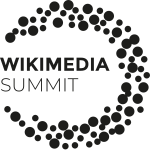Wikimedia Summit 2019/Documentation
| Wikimedia Summit 2019 |
Program | Fringe Events | Registration & Participants |
Location |
Logistics |
Contact |
Documentation, Reports, Reviews |
| Venue and Hotel |
Introduction
Structure of this report
This is the report for the Wikimedia Summit 2019. The report follows day-by-day activities at the event to offer the reader a sense of the journey followed by the Summit’s participants, their reflections and what was generated as result.
The report is divided by day, which had a specific focus. Within each day there are sessions, sometimes involving to the whole group of participants, sometimes involving in parallel members of the Movement Strategy Working Groups (A) and other affiliates attending the Summit (B). Each section — day or session — start with a short outline of what that moment was about.
The report is written in indirect speech, focusing on the gist of the message rather the exact words said by participants or speakers at the Summit. Some of the text written by participants in the course of activities has been transcribed into this report, and when available, links to all original documents are made available throughout in their respective sections.
The Process: Step-by-Step!
Day 1 / Downloading – Friday, March 29 | |
| 1. RE-CONNECTING
The hosts of the event welcomed the participants, with speeches from:
Cornelius Kibelka & Daniela Gentner, leading Coordinators for the Wikimedia Summit, welcomed participants and introduced the new Wikimedia Summit. | |
| Group photo
| |
| 2A. WORKING GROUP TIME
Thematic Working group members gathered to review their own journey until the Summit, followed by questions to Wikimedia Foundation and Movement Strategy Core Team representatives, and then making use of in-person time to advance their work. |
2B. YOUR INVOLVEMENT IN THE MOVEMENT STRATEGY PROCESS
Onboarding other affiliates with a glimpse of the Movement Strategy, identifying the most critical questions concerning the Movement Strategy for those not involved in Working Groups and newbies, followed by interaction with Katherine Maher. |
| 3A. WORKING GROUP TIME
Working Groups worked autonomously, making the most of in-person time and preparing themselves for conversations with a wider range of stakeholders on the 2nd day of the conference. |
3B. YOUR INVOLVEMENT IN GOVERNANCE – ASBS
Affiliates gathered to discuss and decide on the process and criteria for electing Affiliate Selected seats in the Wikimedia Foundation Board of Trustees. |
Day 2 / Processing – Saturday, March 30 | |
| 4 + 5. CHANGING MOVEMENT STRUCTURES
Working Groups’ members engaged other participants in the Summit, gathering their perspectives on the scoping questions. | |
| 6. PROGRESS CHECK-IN
Messages of support for Movement Strategy from the Board of Trustees and joint reflections with Summit participants. |
Day 3 / Uploading – Sunday, March 31 | |
| 7A + 8A. WORKING GROUP TIME III
After presenting the next steps leading to the recommendations in Movement Strategy, the thematic Working Groups developed their plans for completion from the Summit until Wikimania, and reflected on the experience thus far. |
7B. YOUR AGENDA (OPEN SPACE)
A facilitated space with opportunities to network and host conversations on themes important to the participants. |
| 8B. WHAT HAPPENS NEXT?
After presenting the next steps towards recommendations in Movement Strategy, affiliates explored how their communities can be involved in the conversations. | |
|
9. CLOSING Wrapping up the Summit with critical reflections from key listeners, a glimpse of Wikimania 2019 and “thank you” from the organisers. | |
Credits
The report was put together by a team of “harvesters”. Several people made it possible by contributing with facilitation, creating infrastructure for documentation, clustering, analysing and transcribing inputs from participants, and photographing activities.
People who have contributed directly to this report:
- Aida Kadrispahic (Photography)
- Anna Rees (Reporting & Social Media)
- Anna Lena Schiller (Graphic Facilitation)
- Bhavesh Patel (Design / Movement Strategy Core Team)
- Cornelius Kibelka (Summit Programme Coordinator)
- Daniela (Summit Logistics Coordinator)
- Gabor Vozari (Graphic Facilitation Support)
- Hişar Ersöz (Studio Amore, Haptic Facilitation)
- Jason Krüger (Photography)
- Julia Kirchner (Facilitation Support)
- Kaarel Vaidla (Movement Strategy Core Team)
- Kilian Schneider (Studio Amore, Haptic Facilitation)
- Luís Manuel Pinto (Reporting)
- Nicole Ebber (Movement Strategy Core Team)
- Nina Cisneros (Live Captioning)
- Olha Kotska (Reporting Support)
- Rob Lancaster (Design / Facilitation)
- Szymon Grabarczuk (Movement Strategy Meta Liaison)
- Most photos of people by Jason Krüger for Wikimedia Deutschland e.V. (Wikimedia Deutschland e.V.).
- Photos of all boards and posts produced at the conference which were taken by Luís Manuel Pinto and Olha Kotska (own work).
- All illustrations and graphics were created by Anna Lena Schiller.
- All presentation slides were developed by the conference organisers and the facilitation team.
- All images have a CC BY-SA 4.0 (http://creativecommons.org/licenses/by-sa/4.0) license.
